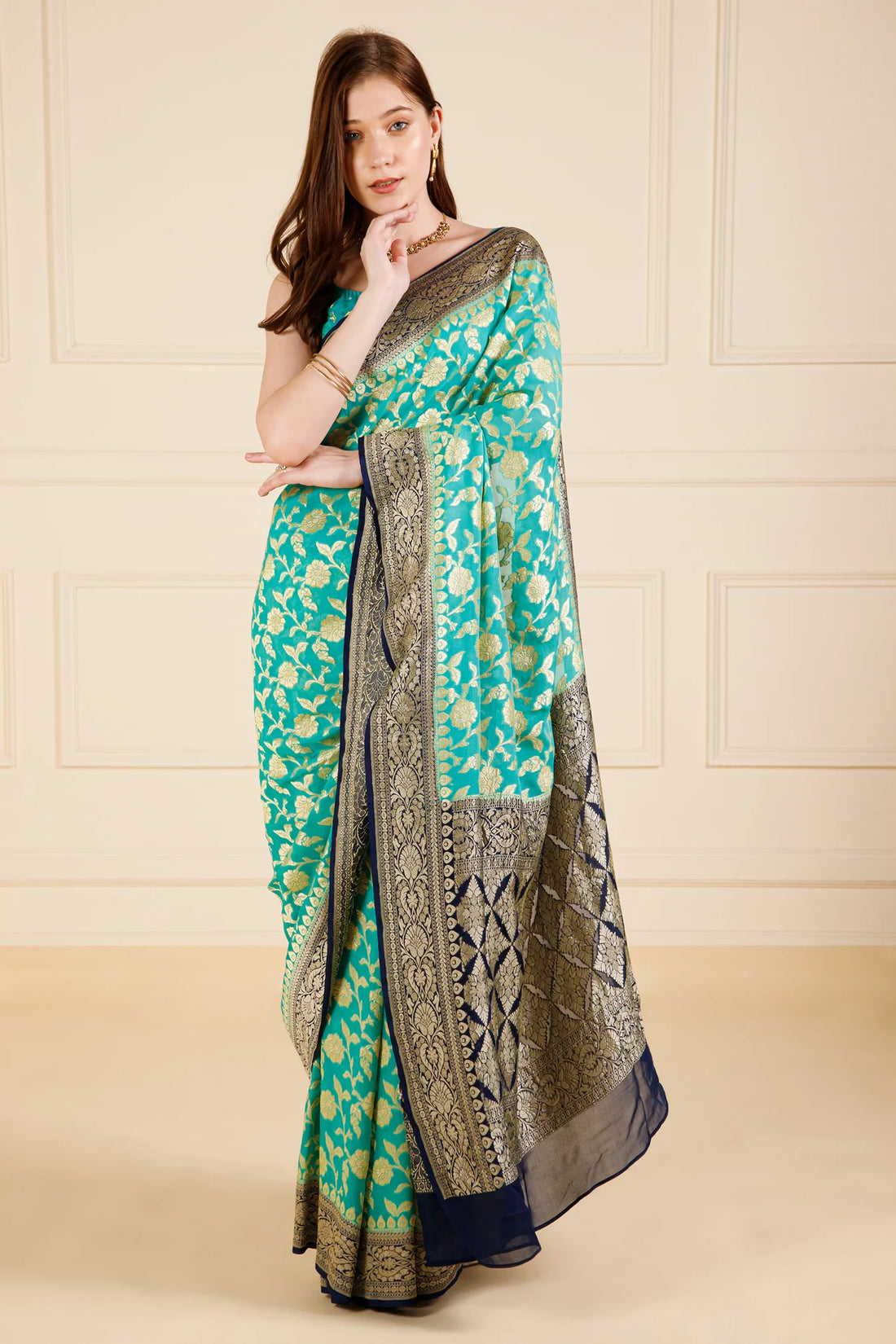
Banarasi Silk Sarees: Types, History, Fashion Trends & Buying Guide
Share
1. Introduction
Banarasi Silk Sarees are a symbol of elegance and luxury in Indian fashion, celebrated for their intricate designs, opulent fabrics, and cultural significance. Originating from the holy city of Varanasi, these sarees have been cherished across generations, often seen as a timeless heirloom passed down through families. This article explores the rich history, various types, unique features, and the significance of Banarasi Silk Sarees, while also providing practical insights for enthusiasts looking to buy, maintain, or wear them.
2. History of Banarasi Silk Sarees
Origin and Evolution
The origin of Banarasi Silk Sarees dates back to the Mughal era, where Persian motifs were blended with traditional Indian weaving techniques. These sarees were initially crafted for the royal families and the affluent class. Over time, the weaving techniques evolved, incorporating influences from different regions and cultures.
Historical Significance
Banarasi sarees were once considered a symbol of wealth and sophistication. During the Mughal period, these sarees became a staple of royal attire, signifying nobility and grace. They continue to hold a special place in Indian culture, especially during weddings and festivals.
Key Influences and Adaptations
Over the centuries, the craftsmanship of Banarasi Silk Sarees has adapted to changing tastes while retaining its traditional charm. The integration of new motifs, styles, and techniques has kept them relevant in the modern fashion landscape.
3. Types of Banarasi Silk Sarees
Pure Silk Banarasi Sarees
These sarees are woven with the finest quality silk threads and feature elaborate patterns made with real gold and silver threads, making them the most luxurious and expensive type.
Shattir Banarasi Sarees
A more affordable version, Shattir sarees are woven with mixed fabric materials while maintaining the traditional Banarasi look.
Katan Silk Banarasi Sarees
Katan is a plain fabric woven with pure silk threads. These sarees are known for their durability and strength, featuring intricate designs created with gold or silver threads.
Georgette Banarasi Sarees
Made from finely twisted yarns, Georgette Banarasi sarees are lightweight and perfect for contemporary fashion. They often feature modern patterns and vibrant colors.
Organza or Kora Banarasi Sarees
Woven with thin threads of silk, Organza Banarasi sarees are sheer and delicate. They are characterized by their lightweight and delicate texture.
4. Weaving Techniques and Craftsmanship
Handloom Weaving
The art of weaving Banarasi sarees on handlooms involves intricate designs that take weeks or even months to complete. Each saree is a masterpiece crafted by skilled artisans.
Brocade Weaving Techniques
Brocade weaving, an age-old technique used in Banarasi sarees, involves creating patterns with a raised, embossed look using gold or silver threads.
Zari Work and Embroidery
Zari work involves weaving sarees with threads of gold or silver to create intricate designs. This embroidery technique adds a regal touch to Banarasi sarees.
5. Unique Features of Banarasi Silk
Patterns and Motifs
Banarasi sarees are renowned for their distinctive patterns, such as floral motifs, geometric designs, and Mughal-inspired patterns. Each motif tells a story of its own, reflecting India's diverse cultural heritage.
Color Variations
While traditionally available in rich shades of red, maroon, and gold, modern Banarasi sarees come in a wide range of colors, from pastel hues to vibrant shades.
Fabric Quality and Finish
Banarasi sarees are known for their luxurious feel, superior quality, and intricate weaving. The silk used is often of the highest grade, ensuring a glossy and refined finish.
6. Regional Variations in Banarasi Sarees
Varanasi vs. Other Cities
Although Banarasi sarees originate from Varanasi, other regions have developed their own variations, such as those from Bhagalpur and Bangalore, which have subtle differences in weaving style and motifs.
Local Craftsmanship Styles
Different regions have unique craftsmanship styles, such as heavier embroidery in Varanasi and lighter motifs in other areas, adding to the diversity of Banarasi sarees.
7. Significance in Indian Weddings
Bridal Sarees and Banarasi's Role
Banarasi sarees are a popular choice for Indian brides due to their timeless elegance and cultural significance. They often symbolize prosperity and marital bliss.
Popular Wedding Designs and Patterns
Traditional bridal Banarasi sarees are often adorned with elaborate zari work, intricate borders, and heavy embroidery, making them a favored choice for weddings.
8. Banarasi Silk Sarees in Fashion Trends
Influence on Modern Fashion
Banarasi silk sarees have found a place in contemporary fashion, with designers experimenting with modern cuts and innovative draping styles.
Bollywood and Celebrities' Love for Banarasi Sarees
Many Bollywood celebrities and public figures have been seen wearing Banarasi sarees at weddings and special occasions, further popularizing them in modern times.
9. How to Identify Authentic Banarasi Sarees
Tips for Identifying Authenticity
To identify an authentic Banarasi saree, check for the fineness of the silk, the quality of the zari work, and the presence of the GI (Geographical Indication) tag, which certifies its origin.
Common Counterfeits and Dupes
Beware of common counterfeit products that use synthetic materials or cheaper silks, lacking the durability and luxury of an original Banarasi saree.
10. Maintenance and Care of Banarasi Sarees
Cleaning and Storage
To maintain the beauty of your Banarasi saree, dry clean it and store it in a cool, dry place away from direct sunlight. Use a muslin cloth to wrap it and prevent any damage.
Preventing Damage and Wear
Avoid using harsh detergents or exposing the saree to moisture. Handle with care to prevent any wear and tear over time.
11. Buying Banarasi Silk Sarees Online
Trusted Online Platforms
Platforms like Myntra, Flipkart, and specialized boutiques offer a wide range of authentic Banarasi sarees.
Tips for Online Shopping
Ensure the platform offers quality checks, customer reviews, and return policies. Look for detailed product descriptions and high-resolution images.
12. Price Range and Market Dynamics
Factors Influencing Prices
Prices of Banarasi sarees depend on the quality of silk, intricacy of design, and the amount of zari work involved. Handmade sarees are often more expensive due to the labor-intensive process.
Current Market Trends
With increasing demand for sustainable and handmade products, Banarasi sarees are experiencing a surge in popularity, both domestically and internationally.
13. Case Studies: Famous Banarasi Saree Designers
Profiles of Renowned Designers
Designers like Sabyasachi Mukherjee and Anita Dongre have incorporated Banarasi sarees into their collections, adding a modern twist to the traditional attire.
Unique Collections and Innovations
These designers experiment with different patterns, colors, and fabrics to create unique Banarasi saree collections that appeal to a global audience.
14. The Future of Banarasi Silk Sarees
Sustainability and Ethical Practices
There is a growing emphasis on sustainable and ethical practices in the production of Banarasi sarees, with many weavers adopting eco-friendly methods.
Emerging Trends and Global Appeal
Banarasi sarees are gaining global recognition for their craftsmanship and quality. They are increasingly being embraced by international fashionistas.
15. FAQs
-
What is special about Banarasi silk sarees?
Banarasi silk sarees are known for their intricate designs, luxurious silk fabric, and rich cultural heritage. -
How can I differentiate between a genuine and a fake Banarasi saree?
Look for the GI tag, high-quality silk, and genuine zari work. Avoid sarees that appear too glossy or light.
Buy Your Authentic Banarasi Silk Saree Here
